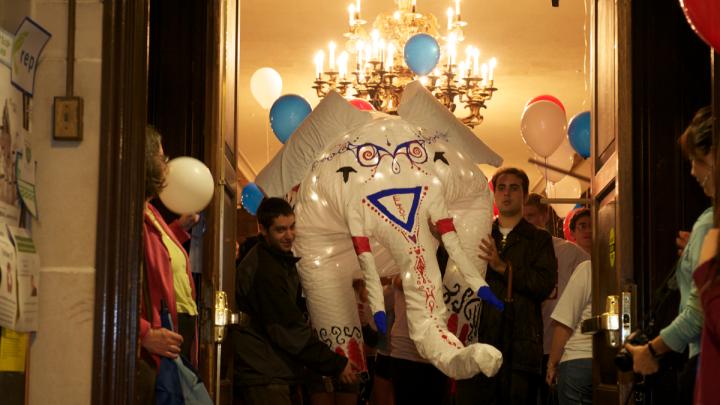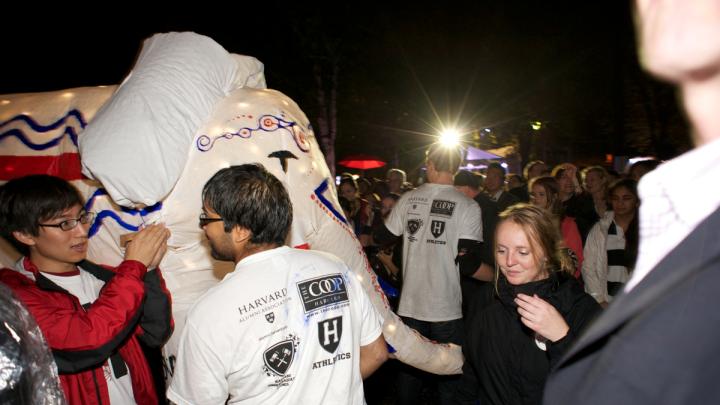“How long do you think that should be? 9 feet?”
“Well, if the roll is 2 feet wide…”
“Okay, cut here.”
Last Saturday—a sunny if brisk day—a half-dozen students in Eliot (including me) were assembling the skeleton of a giant paper-lantern elephant (Eliot’s mascot) in the courtyard out of a roll of chicken wire, zip ties, and half-inch PVC piping. It was a project in improvisation.
“Do you think this looks like an elephant’s head?”
“What does an elephant’s head look like, anyway?”
The elephant, when assembled, was going to serve as the highlight of Eliot’s procession into Harvard Yard for the University’s 375th anniversary celebration. It was the brainchild of Morgan Lehmann ’12, who had volunteered to lead the Eliot House subcommittee delegated to prepare our part in the anniversary. “I feel like I haven’t done anything else all week,” she mentioned to me last night as we prepared to march up to the Yard. “And I had midterms, too!” Given that the job entailed getting T-shirts distributed to several hundred undergrads, making sure that everyone knew about the existence of the festivities, inflating huge numbers of glow-in-the-dark balloons, and constructing a luminescent elephant, her exhaustion made sense.
By the time the elephant was finished, draped in white cloth, painted, and outfitted from the inside with white solar lights, it looked nice—pleasantly arts-and-craftsy. And that, according to University marshal Jackie O’Neill, is exactly what had been hoped for in planning the event: “President Faust was very clear that she didn’t want to do something that was extravagant and over-the-top. She wanted something that was more like a home-grown family get-together.” All the undergraduate House committees were contacted and asked to contribute something imaginative for the procession. Dining services was planning to serve an elaborate, history-themed dinner, with dishes from different points in Harvard’s history. There would be drinks and an enormous cake and a band. Which made me wonder—did any of this happen last time?
I remember hearing Alan Gilbert ’89 (now director of the New York Philharmonic) tell a story at a Q&A event a couple of years ago about being sneaked in the door of Sanders Theatre by Leonard Bernstein ’39 for the huge gala celebration of Harvard’s 350th anniversary—which consisted, by his account, of a bunch of University dignitaries in formal dress delivering remarks to one another. So when I first heard about the carnivalesque plans for this anniversary, I was surprised by the openness of it all. O’Neill recalls that the big highlight then was not an enormous cake, but rather the visit of Prince Charles. “We’re not the same institution that we were 25 years ago,” she notes. “If you look back, students were invited to things, but it wasn’t the whole student body who was asked to participate. This is different, because every student in the undergraduate, graduate, and professional school communities has been invited to attend. This event is designed as a Harvard family birthday party.”
Back in Eliot, Friday evening found the celebration beginning with a huge crowd in the dining hall, even as the rain grew steadily more torrential outside. The line for food was long, though reactions were mixed: the Welsh rarebit went over well (“Why can’t we have this every day?”), but the chicken pot pie did not (“Don’t they serve this like every week anyway?”). Many students, including both my roommates, had to eat quickly before heading up to the Yard early to take part in one of the 40-odd performances being staged around Tercentenary Theatre—in fact, this seemed true of half of the people I know. “The driver of the event is to showcase the talent, energy, and diversity of our students,” O’Neill told me, and it did seem as though her office had gone out of its way to find all my talented, energetic, diverse friends. The Asian American Dance Troupe, the Harvard University Band, The Harvard Undergraduate Drummers (THUD), the Harvard University Stand-Up Comedy Society, the Harvard Storytelling Club, the Harvard-Radcliffe Orchestra, the Holden Choirs, the Kuumba Singers, and so many more—in fact, every major performing arts group on campus had been asked to appear, it seemed, and appear they did.
That left the rest of us, of course, to play our part. When the time came to proceed up to the Yard, the rain had crescendoed to a monsoon tattoo, meaning that we would have to shelter our elephant lantern with a large tarp held aloft as an umbrella. Only as we were about to head out the main door did we realize that the elephant was too wide, meaning we’d have to leave through the back gate. Eliot House master Gail O’Keefe helped us carry the entire thing along Memorial Drive—ultimately an eight-person job, requiring as it did one person for each corner of both elephant and tarp. We trudged through small lakes that had puddled in the pavement; dozens of soakable canvas sneakers met their match. The mackintoshed parade hollered steadily woozier renditions of the Eliot House song, blocking disgruntled traffic with our glowing elephant as we headed up Plympton Street.
We entered the Yard through the Widener Gate and were signaled to the left, where we waited between Boylston and Wigglesworth. And waited. And waited some more. People were getting anxious, wet, and bored. One of the plywood rods holding the elephant’s front left leg straight snapped. Rain kept collecting on the tarp-canopy above, and spilling unceremoniously onto bystanders. Eliot cheers turned into cheap heckling of the Winthropites standing ahead of us. People kept peeling off to look for food and ponchos. “We told them we were going to lose people if we had to wait like this!” one of our House committee chairs complained to no one in particular. The rain washed in and out and then in again. We tried frantically to reorganize the scaffolding of the elephant to get the leg to hold. While holding the elephant up, I realized that we were missing all of the performances in the Yard, and then it occurred to me why we were being held here: we were supposed to be the last performance.
It all went by so fast: we walked past the Widener steps, and then to no place in particular. Our other House master, Doug Melton, said that he and Gail would take the elephant back to Eliot. I didn’t have an umbrella, so I pulled the hood of my raincoat over my head and wandered through Tercentenary Theatre. People swarmed everywhere in the rain, apparently headed every direction but my own. The combination of rain and feet had turned the entire area into a giant mud pit; a single blade of grass was nowhere to be seen. Between the rain washing off my jacket and the mud splattering over my legs, my jeans were wet as a sponge.
I found a huddled pod of onlookers, shawled in damp ponchos, taking refuge in the archway of Sever Hall. “But we were wet before we even came in the Yard,” explained Leslie Dingee, mother of William Dingee ’15. Having come up for Freshman Parents’ Weekend, she and her husband had managed to see the cake and some dancers before deciding to wait the rain out. “We’re looking forward to the music later,” when the rain lets up, she mentioned, as were many others—the Harvard-Radcliffe Orchestra, Holden Choirs, and Yo-Yo Ma.
I ran across a few friends who just couldn’t cope anymore. “We’re headed to a bar,” they said. And as far as I could tell, the number of undergrads in attendance generally seemed to be dwindling. I was pretty tempted to find someplace drier, too, when suddenly it was announced that everyone would have to go inside—lightning had been spotted. I decided to take the occasion to run back to Eliot to put on a different pair of pants and get an umbrella.
Now somewhat drier, I walked back up and returned in the middle of a rendition of the “Ode to Joy,” intensely amplified through a dozen speakers. Live Beethoven and a 15- by 18-foot birthday cake seemed a little ostentatious for a “home-grown family get-together,” but it would be uncharacteristic of the University to do anything small—and it was a much-needed pick-me-up after the dismal rain and mud. Yo-Yo Ma played a couple movements from the first Bach cello suite (I found myself wondering if he ever gets tired of playing them), and then University provost Alan Garber cut the cake with a knife the size of a four-year-old child. A mass of the hungry thronged the cake tent on all sides; it was not weather conducive to lines or patience.
The Jimmy Vali Band, hired for the occasion, struck up on the steps of Memorial Church, and an initially demure crowd gradually grew a little warmer, even as the rain continued to shower down. While there was some disagreement and confusion over the name and significance of the band—“Frankie Valli?” “Jimmy Vali?” “Didn’t they play for Chelsea Clinton’s wedding?”—the impression was generally enthusiastic as they delivered intricately accurate covers of songs ranging from “I Gotta Feeling” to “Don’t Stop Believin’ ” to a song I never imagined I’d hear blasting from Memorial Church to Widener, Miley Cyrus’s “Party in the U.S.A.” “Come on,” one of my friends goaded me. “You just have to go along with it.” I doubt that it was the case, but I’d like to at least entertain the possibility that somewhere Yo-Yo Ma and President Faust might have been dancing to that, too—or at least, you know, nodding their heads, like, yeah.











